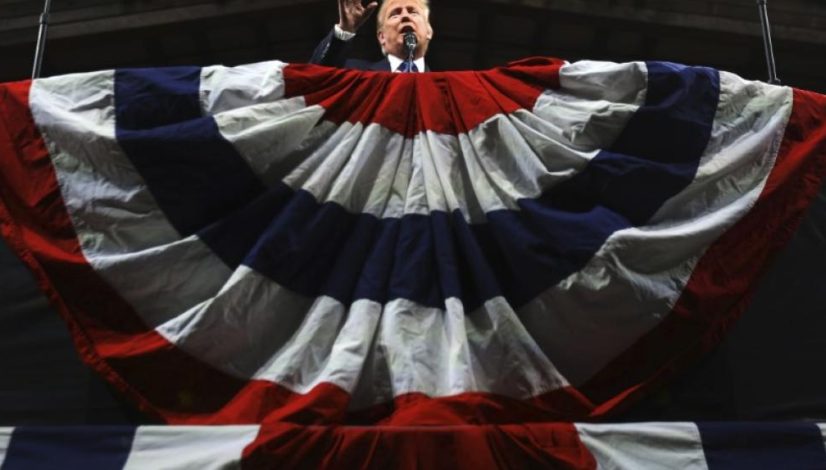Trump Has One Card to Play and He Better Play It Now: The Economy
Is Trump washed up? Done for? Kaput? Probably not, but he has surely taken a thrashing this past few days. Boiling it all down, there are two lessons for the tycoon-turned-pol. The first: take your personal business – including your sleazy university – off the table. You are now running for the highest office in the land, the most powerful position on earth, and heading one of the two great political parties of this great nation. Nobody cares about your stupid lawsuit or your personal vendetta against the presiding judge. That’s your past. Onto the future.
The second: take control of the conversation, and focus on what is important to voters. If you want to be president, you need to craft a message that will appeal to the majority of American voters. Not just disgruntled white guys – you need to convince women and minorities too that you can follow through on your promise to bring jobs back to this country.
Trump has made a good start. Voters give him the edge over Clinton – 53 percent to 43 percent according to Gallup—on handling the economy; that is also their number one concern. It doesn’t take a genius to figure out that should be the sole focus of his campaign.
For Republicans, one of the most horrifying aspects of the Trump vs. Mexican heritage judge saga is that the presumptive GOP nominee missed a huge opportunity. He should have fastened like a limpet onto the May jobs report, hammering away at the Obama economy and at Hillary’s promise of four more years. The disappointing 38,000 jobs created last month reduced Obama’s victory lap to more fluff and spin, and Hillary’s embrace of the president’s agenda to more bad judgement.
Jobs may, of course, bounce back next month. Indeed, we may all end up wondering whether the White House magicians didn’t pull some rabbits out of hats to prevent a potentially damaging Fed interest rate hike. Nonetheless, as Hillary limps across the finish line, Trump should be uniting his party and building momentum as he heads to the convention. Instead, he has allowed critics to pound him as a racist, sending GOP teammates scurrying for cover. Coming on top of Hillary Clinton’s first break-out speech of the campaign last week, in which she tore into the billionaire, we can expect to see Trump take a hit in the polls.
Maybe this is a good thing. Maybe this is a teachable moment; we need to see a little less swagger and a little more statesmanship from Mr. Trump. He could start with blasting away at the Obama economy, and supplying real ideas for making it better.
He also has to learn the oldest political trick in the book. What Trump should have said when asked about his criticism of Judge Gonzalo Curiel is, “Before I answer that, I want to comment on Friday’s jobs report.”
Because of the excitement over Trump’s flub, there hasn’t been much discussion of May’s disappointing jobs tally. Not only was job creation weak, but another 458,000 people left the work force, causing workforce participation to decline again. This persistent failure of Obamanomics is meat and potatoes for Trump’s campaign.
There’s more. The number of people “not in the work force” was put at 94.7 million, up more than 600,000 from a year ago. That compares with only 151 million people working. The implicit fiscal burden on American workers is only going to grow as the country ages. Higher taxes and reduced benefits will inevitably follow.
The figure not working includes the nearly 9 million Americans (10.8 million including widows and children) – nearly one in twenty adults—receiving disability payments from the Social Security Administration, a number that has doubled since the early 1990s.
The disability program has morphed into one of the greatest scams ever perpetrated on the American taxpayer. The annual cost to the federal government is greater than the outlays for food stamps and welfare combined. Studies have shown that the increase in beneficiaries is not because workers are getting older or sicker; the health and longevity of the country has steadily improved. No, the rise is because, as Jordan Weissman in The Atlantic wrote a couple of years ago, “Qualifying for disability got easier, and finding work got harder.” Though the number of people on disability tends to rise and fall with employment levels, the underlying increase reflects that “the system is being abused,” concludes Weissman.
Trump has vowed to cut waste and fraud in government, but has been sketchy on the details. The disability program, which has been exposed as corrupt by numerous investigations, is a story he could tell. He can talk about Hale County, Alabama, where one in four working-age adults is on disability. It can serve as a prime example of how well-meaning liberal programs can undermine employment.
Another useful tidbit from the jobs report is the continuing employment gap between blacks and whites. Black unemployment in the past month was 8.2 percent; this was down from the 10 percent level a year ago but twice the level of whites. That comparison has persisted for decades, and has not improved during Obama’s presidency. Hillary Clinton is running on President Obama’s policies – policies which have arguably done little for African-Americans. Trump should make that case to black voters, and remind parents that 27 percent of black teens are jobless, compared to 14 percent of whites.
Meanwhile, productivity slumped again in the first quarter, and for the third year in a row more businesses failed than opened up their doors. When Trump says, “We don’t win anymore,” he hits a nerve.
More than any candidate in memory, Donald Trump holds his future in his own hands. Imagine: he could actually become president of the United States, by gradually broadening his appeal to American voters, or he can continue the childish insults and bullying that got him this far. This would seem to be an obvious choice. It is, however, one he may be incapable of making.




